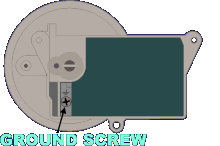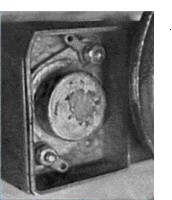Hacking (up) the Opus Ignition
A while back, I decided to dig the secrets out
of the Lucas Opus distributor in one of my TR7s. Since the Opus
ignition has a reputation as one of the least reliable products ever
made by Lucas (yikes!), I expected to find all sorts of bone-head
design errors and shoddy components incorporated into the design. For
the most part, I found exactly the opposite! The components are top
quality, and the unit has several thoughtful design features that
show that the designer knew his stuff. It's actually much
better quality than the distributor in the TR8. But, of course, it
couldn't carry the Lucas label without having manufacturing mistakes
that would negate all of the care the original designers lavished on
it - I'm sure Dilbert's boss had a hand in the production
engineering.
If your Opus distributor is intermittent or dead, you may want to
investigate the following items:
 1. A bad internal ground connection.
The circuit board electronics are grounded by a ring terminal screwed down to the distributor
housing. A "star" washer is used to lock it down and
provide good electrical contact. Unfortunately, the whole assembly
is potted with a highly filled, very hard epoxy, and no provision
was made to keep it away from the ground screw. The epoxy flows in
and around the washer, destroying its ability to apply pressure
between the screw and ring terminal, much like stiffening the car's
ride by encasing the road springs in concrete. After a few thousand
thermal cycles, I wouldn't hold out much hope for a good ground.
1. A bad internal ground connection.
The circuit board electronics are grounded by a ring terminal screwed down to the distributor
housing. A "star" washer is used to lock it down and
provide good electrical contact. Unfortunately, the whole assembly
is potted with a highly filled, very hard epoxy, and no provision
was made to keep it away from the ground screw. The epoxy flows in
and around the washer, destroying its ability to apply pressure
between the screw and ring terminal, much like stiffening the car's
ride by encasing the road springs in concrete. After a few thousand
thermal cycles, I wouldn't hold out much hope for a good ground.
You can burrow down to the screw using a 30 to 60 watt pencil
type soldering iron, or a small ice pick heated on the kitchen
stove. You will have to re-tin the soldering iron after mistreating
it like this, so you might want to have some non-corrosive soldering
paste handy. Press the point of the iron gently into the epoxy over
the screw. The epoxy will immediately disintegrate and become
crumbly as it heats. Too much heat or pressure are counter
productive. After removing enough epoxy, unscrew the screw and reach
down onto the hole with a sharpened jeweler's screwdriver to scrape
things clean. Clean the screw and washer and reinstall them snugly.
Squirt some dielectric grease into the hole to seal things back up.
 2. A shorted-out output transistor.
2. A shorted-out output transistor.
This is sooooo
dumb, it's funny. Instead of putting flat washers under the transistor mounting
nuts, the folks at Lucas used small ring terminals that probably came with the
transistor mounting kit. Tightening the nuts cause the ring
terminals to rotate until they touch the distributor housing,
shorting out the transistor. If the terminals only touch the housing
gently, thermal expansion would cause the short to come and go. On
my distributor, there was no short until I applied gentle pressure
to the top of the transistor with my thumb. I doubt that all the
Opus distributors have this problem, but it's worth checking.
Unplug the distributor and connect an ohmmeter between the gray
striped white wire and ground. Press on the epoxy covering the
transistor with your thumb, or heat it with a hair dryer. If the
ohmmeter reading is constant and non zero (you might read the
resistance of a diode that's in the circuit) you're OK. If the
reading jumps around, dig into the epoxy with a soldering iron and
take a look.
3. External Wiring. Even the wiring that is
attached to the distributor is a little weird. The finned resistor screwed down
near the coil is not the ballast resistor. It supplies current to the base terminal
of the distributor's output transistor. Most other cars have the "base drive"
resistor mounted inside the ignition module along with the rest of the electronics. If you
upgrade your car with an unballasted "sport" coil and bypass that resistor, thinking it's the ballast,
you'll instantly blow up the distributor. The TR7 ignition ballast is a long resistance
wire inside the dash harness. It is white with a pink stripe and can be seen if the
fake speaker grille on top of the dash is removed.
4. Bad ferrite. If the core of the sensor is cracked, it's
time for a Luminition. The sensor consists of a coil wound on an "E"
shaped core made from ferrite. Ferrite is the stuff speaker magnets
are usually made from. It's very hard and brittle, like glass. If it
receives a hard shock, it will crack - but unless you pulled your
distributor and tossed it down onto the driveway, any cracking would
most likely be caused by thermal cycling. If ferrite is glued to
something that expands and contracts at a different rate, eventually
it will crack. One posting to the TR7/TR8 mailing list described
a problem with cracked ferrite pins in the rotor, and another where
some had fallen out.
You might try checking things out like this - Unhook the coil
and replace it in the circuit with a small light bulb. Turn on the
ignition and rotate the engine by hand until one of the pins in the
disk below the distributor rotor lines up with the small "nubs "
sticking out of the sensor. The light should go out. Gently heat up
the area around the sensor (not too much!) with a hair dryer and see
if the light blinks on. If it does, the pin or the sensor may have a
problem, or the gap between the sensor and the rotor is too great.
Turn the engine some more to check each pin in turn. Don't overheat
things, and you might want to monitor the temperature of the drive
resistor mounted near the coil on the fire wall, to be sure it
doesn't get too hot.
Also note that if your distributor has a vacuum unit,
it is most likely for retarding the timing at idle rather than advancing it
when the engine isn't loaded. If the vacuum capsule diaphragm splits, it will
cause the engine to idle too fast. If you're trying to diagnose a suddenly
too-fast idle and find the timing advanced, resetting it without checking the
distributor's condition may result in a significant performance loss or
overheating due to retarded timing at speed.
Click on pictures to enlarge.
|
